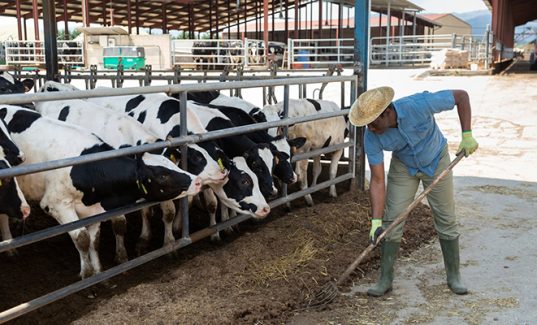Heat stress is a factor that significantly affects the comfort and productivity of cattle according to Ted Probert, dairy specialist with University of Missouri Extension.
“Now is a good time for producers to evaluate how effectively their herd management addresses the issue of heat stress for their herd,” said Probert.
All cattle are affected by elevated temperatures and will respond favorably to efforts to keep them comfortable.
“Lactating dairy cattle are the most vulnerable to stress associated with high heat and humidity,” said Probert. “Although I focus on milk cows, the basic concepts of heat stress abatement apply to all classes of cattle and other livestock as well.”
SIGNS OF HEAT STRESS
Cattle are most comfortable when temperatures range between 25 and 65 degrees Fahrenheit. As the temperature rises above this level cattle slowly begin showing signs of heat-related stress.
The higher the temperature rises, the more severe these symptoms become. Humidity also plays a role in the severity of heat stress.
“The two factors of temperature and humidity acting together determine the degree of discomfort cattle endure at any given time,” said Probert. “The combinations of heat and humidity are expressed in a temperature-humidity index. The closer the index gets to 100 the higher will be the level of heat stress.”
Cattle under heat stress exhibit physiological and behavioral changes including increased respiration rate, elevated body temperature, reduced feed intake, and decreased milk production. Additionally, volatile fatty acid production in the rumen is altered resulting in the possibility of acidosis and a lowered butterfat test. Heat stress can significantly decrease conception rates.
NUTRITIONAL MANAGEMENT
“Heat induced stress causes lowered feed intake. Anything that can be done to prevent or circumvent lowered intake will be a positive move toward heat stress abatement,” said Probert.
Use of nutrient dense feeds is important during the heat of summer. Use of high-quality forages will reduce heat produced during digestion and offer more nutrients per unit of intake. Altering the proportion of forage to concentrate in the ration and adding extra fat are other strategies for increasing nutrient density.
“Feeding most of the ration during cooler parts of the day will minimize digestive heat production and improve intake. More frequent feeding will help compensate for feed deterioration when silage is a ration component.
“Pasture fed cattle will benefit when allowed to graze in shaded pastures during the heat of the day. Non-shaded pastures can be used at night,” said Probert.
Cows lose minerals through sweating. This is more pronounced during hot weather. Appropriate ration levels of some important minerals during periods of heat stress include potassium (1.50%), sodium (.50-.60%), and magnesium (.30%).
ADEQUATE WATER
Cows also increase their water intake during hot weather. Adequate water availability is extremely important during this time of year.
“Keeping water fresh and as cool as possible will encourage intake and help cool cows. Cows will drink more if they don’t have to walk too far to their water source,” said Probert.
A final consideration would be the effect feeding endophyte-infected fescue can have on cattle during hot weather. The ergovaline present in infected fescue causes constriction of blood vessels, reduction of blood flow, and reduced heat dissipation.
“Feeding endophyte-infected fescue will increase the stress that cows are subjected to during hot weather, further intensifying all the problems they endure when under heat stress,” said Probert. “Substitution of alternate forages in place of fescue during hot weather will make a significant impact toward combatting heat stress.”
COOLING STRATEGIES
Shade is the first thing to address when designing cow cooling systems. The shade will reduce the animals’ exposure to solar radiation and the amount of heat they absorb.
The most important areas for providing shade include holding pens, feeding areas, and resting areas. Shade can be provided naturally (trees), by permanent buildings, or by portable structures.
“Shade cloth can provide an inexpensive means of shielding cows from the sun. Plans for portable shades are available from your local MU Extension office,” said Probert.
The addition of fans in shaded areas will complement the benefits provided by shade. Fans are useful for increasing air movement around cows. Two areas where fans are beneficial are in the holding pen and where cows rest.
Sprinklers are the third component of the most effective cow cooling systems. Sprinkler systems offer the benefits of cooling the air around cows as well as cooling cows directly by wetting them then allowing the water to evaporate from the cows’ skin.
Sprinklers should be used in conjunction with fans to create an environment that combines the cooling effects of water and air movement working in tandem.
“Cooling cows just twice daily while they are on the holding area can have a significant impact on cow comfort and performance,” said Probert.
For further details on installation of heat stress relief systems or assistance in designing a system for your farm, contact either of these MU Extension dairy specialists in southwest Missouri. Reach Ted Probert in Wright County at ![]() (417) 547-7500 or by email at probertt@missouri.edu, or Reagan Bluel in Barry County at
(417) 547-7500 or by email at probertt@missouri.edu, or Reagan Bluel in Barry County at ![]() (417) 847-3161 or by email at BluelRJ@missouri.edu.
(417) 847-3161 or by email at BluelRJ@missouri.edu.
Source: University of Missouri Extension




